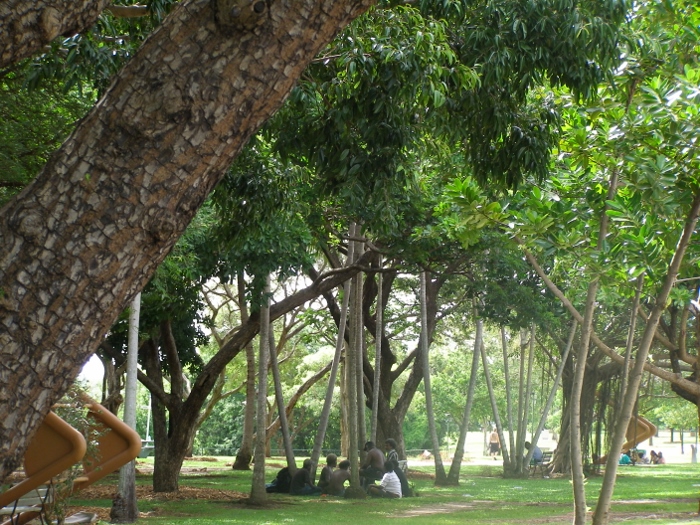Wonu Veys travelled to Australia as part of an international collaborative project entitled Globalization, Photography, and Race: The Circulation and Return of Aboriginal Photographs in Europe. She has worked extensively with the photographic collections found within the Musée du quai Branly, but more specifically with pictures from the Museum of Ethnology.
The following is a blog account of Wonu’s travels that have been translated from Dutch to English.

Part of the new architecture from the National Museum of Australia, which was completed in 2001
The collection of Alex van der Leeden (Wednesday, February 19th, 2014)
During his research in Arnhem Land and more specifically in Numbulwar (1964-1965), Alex van der Leeden gathered a total of 75 objects. Unlike his photo collection, his object collection is exceptionally well documented. The collection is in three museums: the Australian Museum in Sydney, the National Museum of Australia in Canberra and National Museum of Ethnology in Leiden. The objects that are located in the National Museum of Australia can be viewed in an open depot.
Visitors come to view the multiplicity and diversity of these objects several times a day. The Alex van der Leeden collection has tree bark paintings, carrying nets, baskets, bracelets and spears. The bark paintings are among the most visually striking objects. Moreover, they are exceptional because bark paintings made this way generally came from the north coast of Arnhem Land and not the east coast. An example is the painting of an emu made by Minju’gak in January 1965. The two rows represent emus from two different stories.
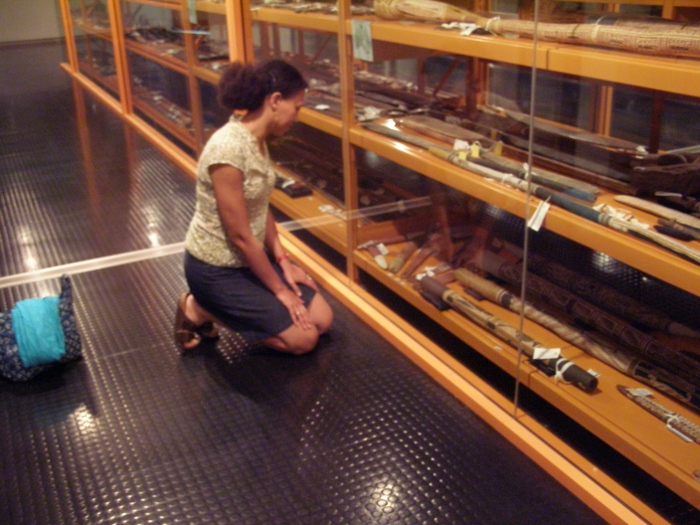
Wonu viewing the objects collected by van der Leeden at the National Museum of Australia
Fieldwork by Alex van der Leeden (Thursday, February 20th, 2014)
After going through the archives at AIATSIS of Alexander Cornelis van der Leeden works, I get a better picture of the man and his research.
For his thesis, AC van der Leeden conducted fieldwork in Sarmi on the north coast of New Guinea from 1952 to 1955. During that period he was employed by the Office of Population Affairs in was known as Hollandia, the current Jayapura.
His work was characterized by the structuralism of Claude Lévi-Strauss. He graduated in 1956 with a thesis entitled, “Main Draw of the social structure in the western interior of Sarmi”. Shortly after, Van der Leeden became the Assistant Curator of the Indonesian branch of the Museum of Ethnology in Rotterdam until 1960. From 1960 to 1969 he was appointed the Curator of the Indonesian branch of the National Museum of Ethnology in Leiden.
It was during his work in Leiden that he received a grant from the Dutch Organization for the promotion of Pure Research (ZWO) and the Australian Institute of Aboriginal Studies (AIAS) to conduct research in Numbulwar. His report shows that he was very well prepared. He had talks with all major linguists, anthropologists and ethnomusicologists from Perth, Sydney, Canberra and Darwin who had previously worked with Aboriginal groups.
With the research funds he received from AIATSIS, he was able to buy a camera with enough film supplies as well borrow their audio equipment for recording. In his reports, he states that the arrival of his wife and youngest daughter to Numbulwar not only made his stay more enjoyable, but it made it much easier to communicate with the local Numbulwar women.
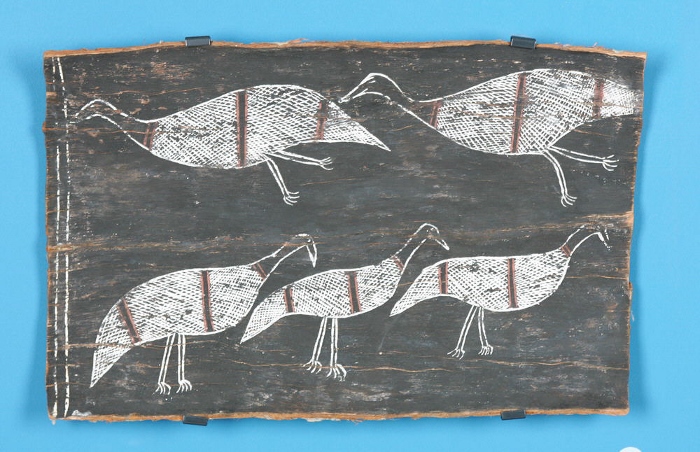
Bark Painting by Minju’gak (1965)
Mapping our world in the National Library of Australia (Friday, February 21, 2014)
Cards are fascinating documents. The exhibition “Mapping Our World: Terra Incognita to Australia ” which is on display in the National Library in Canberra shows the development of cartography since the first modest attempts in antiquity to the most advanced achievements of contemporary times.
The stories that are linked to it, are extremely fascinating! The exhibition begins with how the original inhabitants, the Australian Aborigines, the scenery and the routes described in the stories of the Dreaming, also shape on the plane.
I read in the introduction to the catalogue of the exhibition that most Australians believe that Captain Cook’s discovery of Australia in 1770 was unprecedented and any previous encounters by others was past over in the history books. However, the exhibition also reports that the first documented contact to the Australian shores was in fact 160 years before Cook by Willem Janszoon aboard the Duyfken.
The fourth section of the exhibition is actually dedicated to the Dutch Golden Age and the Dutch East India Company: stunning travel maps and atlases ornate witnesses of this period. The landing of the Duyfken in 1606 is presented on a map of Hessel Gerritsz, while a Bonaparte Card and Huydecoper diary represent Tasman’s voyage. Although the exhibition, at first glance was unrelated to my current project of researching Alex van der Leeden’s work, it did reveal a long history of research and contact between the Netherlands and Australia.

Dida Main and Wonu look at the photographs taken by Alex van der Leeden
Review (Saturday, February 22, 2013)
After a journey of seven hours with two flights, I arrived around noon from Canberra to Darwin, the northernmost capital of Australia. On the way to the city center you will see small termite mounds everywhere. Remarkably, there are no mosquitoes in the subtropical climate at this time.
I had an appointment with Mick and Dida Main Uibo a little life outside Darwin. Dida Main was born in Numbulwar and the conversation with her gave me a taste of the stories that I will get to hear in Numbulwar. Unlike many anthropologists in the Netherlands, Dida knew very well just who “Dr. van der Leeden was. He had come with his wife and his daughter Anne Lise and she remembered as a little girl always being silent when Dr. van der Leeden was making sound recordings.
Dida Main knew the names of just about every person in the pictures. As it turned out, Mick and Dida Main’s daughter teaches at the high school in Numbulwar, and was able to inform everyone of my arrival. I wonder how people will react to the pictures and objects?
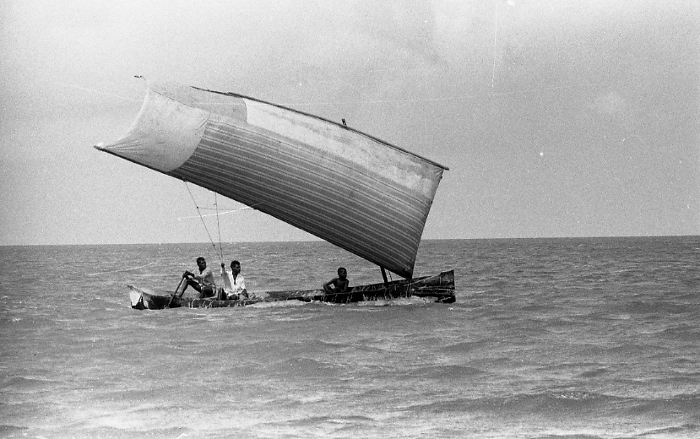
Men in traditional sailing canoe ( Alex van der Leeden collection , 1964-1965)
Darwin (Sunday, February 23, 2014)
The first settlement was called Palmerston in 1869, which was renamed Darwin in 1911. The city has few historic buildings and has in fact been entirely rebuilt twice: the first time after the Japanese air raid on February 19, 1942 and the second time after the Hurricane Tracy almost completely destroyed the city in 1974.
Everyone I speak to wonders whether the new high-rise buildings (up to 40 floors high) will withstand the hurricanes that hit Darwin during the rainy season. Due to its geographical location in the north of Australia is the city’s gateway to Indonesia and East Timor. More than in other Australian cities there are also many Aboriginal people sitting in the shade of the banyan tree or the gum trees. Darwin was built on country traditionally belonging to the Larrakia people.
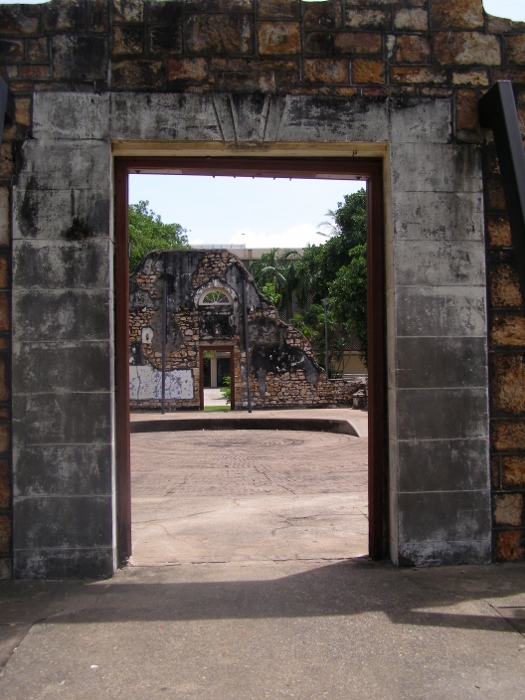
Remnants of the old town hall building, which was destroyed by Hurricane Tracy in 1974
